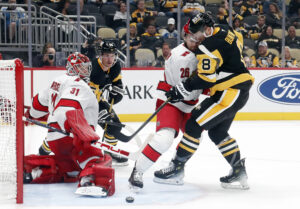The Starting Six series comes to you to dive into the best player at each position all-time for every organization. The biggest and best at each position, with the most memorable moments in franchise history. Here is the Detroit Red Wings all-time lineup.
The Detroit Red Wings have had a storied 90-season history and they’re not afraid to tell you about it and celebrate it, hence the recently expired 25-season playoff streak. There is good reason to however, as the number of players, moments, and championships seems limitless in Detroit’s history. When “Hockeytown” was Hockeytown. Narrowing down the starting six for the franchise is a quite a difficult task. Here is an attempt to do so.
Starting Six: Detroit Red Wings All-Time Lineup
Center: Steve Yzerman (1983-2006)
With his number 19 hanging in the rafters, there’s not a more iconic modern-day Red Wing than Yzerman. Drafted fourth overall in the 1983 NHL Entry Draft, he debuted that season and immediately made an impact at the end of the “Dead Wings” era. Yzerman was named the youngest captain in team history in 1986 at 21-years-old. From 1966-83, the team made the playoffs twice in 17 seasons. They missed the playoffs twice in his 22-season career.
Through it all, he scored 692 goals and 1,755 points in 1,514 games. From 1987-93, he was among the game’s best with six consecutive 100-point seasons that saw him score 50-or-more goals five of the six years, topping out at 65 in 1988-89. In Red Wings history, the now-general manager of the Tampa Bay Lightning ranks fourth in games played, second in goals, first in assists (1,063), second in points, first in powerplay goals (202), first in shorthanded goals (50), and first in game-winning goals (94).
However, under head coach Scotty Bowman, Yzerman gradually sacrificed regular season offense for championships when he took over in 1993. In the postseason however, Yzerman still has an incredible resume, scoring 70 goals and 185 points in 196 games. That earned him a Conn Smythe in 1998 when the team won back-to-back Cups, leading a team that persevered through losing teammate Vladimir Konstantinov on the ice carrying his belief that came from off of it. He lead 2002’s incredibly built Hall of Fame squad to a third Championship in six years on a bum knee and still scored six goals and 23 points in 23 games. Out of every moment Yzerman created, however, the most iconic came in a year in which his team didn’t even make it to the Stanley Cup Final.
Left Wing: Ted Lindsay (1944-57, 1964-65)
When Lindsay holds the title as a left winger that was a part of a trio that was named “The Production Line,” it’s hard to leave him out of the Detroit Red Wings all-time lineup. His number seven is also in the rafters, forever immortalized. For starters, he won four Stanley Cups in six years, all with the Red Wings. A nine time all-star, highlighted by a 1949-50 Art Ross Trophy season where he scored 23 goals and 78 points in 69 games, Lindsay finished his career with 379 goals and 851 points in 1,068 games. He notched 11 20-plus goal scoring seasons and 10 50-plus point campaigns over his 17-year career.
His contributions extend from beyond the ice sheet. Near the end of his career, his efforts with Montreal Canadiens defenseman Doug Harvey set in motion the idea for a players union that eventually became the NHL Players Association. This came with sacrifices, as his captaincy was stripped and head coach Jack Adams spread fabrications to the media about him having grievances against teammates after he had him traded to the rival Black Hawks (the space between existed back then), just so the Wings players would reject the union idea. For his contributions to the game, the Lester B. Pearson award, given to the most outstanding player in the regular season as voted on by NHLPA members, was renamed to honor Lindsay’s legacy.
Retiring from the game in 1960 as a Black Hawk, Sid Abel, a linemate on the famous “Production Line” and the general manager/coach at the time, encouraged him back to play one more season in Detroit in 1964-65, where he scored 14 goals and 28 points in 69 games after five years out of the game, a testament to Lindsay’s skill and legacy for the franchise and the game. The official NHLPA would come to fruition two years later.
Right Wing: Gordie Howe (1946-71)
“Mr. Hockey” says it all. What more can be said that has already been said?
In an attempt to do so, chronicling his quarter-century as a Detroiter is quite enjoyable. Through it all, he scored 786 goals and 1,809 points in 1,687 games as a Red Wing, tallying an incredible 14 30-goal seasons and just as unreal 18 70-point campaigns. His playoff career was equally as legendary, if not better, scoring 68 goals and 160 points in 157 games, winning four Stanley Cups with Lindsay and Abel on his line that, to say “produced,” would be an understatement. He also posted 1,643 penalty minutes, and more often than not was willing to drop the gloves and twirl with an adversary.
Even after he left to play in the WHA with his sons Mark and Marty for six seasons dominating in his 40’s scoring 174 goals and 508 points in 419 contests, he returned to play one more season in 1979-80 when the Hartford Whalers moved into the NHL as a five-decade player. Howe tops many lists in not only Red Wings history but overall hockey lore. His 801 goals ranks second to Gretzky and his 1,850 points ranks fourth behind him, Jaromir Jagr and Mark Messier. He made a league-record 23 all-star appearances, racked up six Hart Trophies, and six Art Ross trophies, all while playing until he was 52, the oldest active player in history. The longevity is mind-boggling to think about in today’s game, but back then when much more extracirricular activities were allowed/penalties against were more lenient, it’s even more insane.
There is widespread belief that his number 9 should not just be retired by the Red Wings but the entire league, like Wayne Gretzky‘s number 99 is. Gretzky called him the greatest hockey player of all-time after he passed last June. There is much more to say about the career and legacy that Howe left after he officially left the ice.
Left Defense: Nicklas Lidstrom (1991-2012)
If you like the nickname theme, set with Howe’s “Mr. Hockey,” how about “The Perfect Human”?
Lidstrom is arguably the best defenseman in NHL history, and, if not the best overall, might just be the smartest to ever lace up the skates. His point totals are impressive enough sitting a 264 goals and 1,142 points in 1,564 games. Respectively, those numbers ranks fifth, ninth, and sixth in NHL history among blue liners. His 550 powerplay points rank first all-time from the back end.
In the playoffs, the resume just gets better. With Lidstrom, the Wings never missed the playoffs and is three behind Chris Chelios for most games played in the postseason at the back end. His 183 postseason points ranks second to Paul Coffey. Not to mention, he was the first European to captain a Stanley Cup Champion in 2008, six years after he won a Conn Smythe trophy as Playoff MVP in 2002.
On the other side of the puck, here is visual evidence of his incredible run of Norris Trophy wins from 2000-08, winning six of seven times before capping his career with a seventh in 2011 at age 40.
In his last five seasons, he posted a 56.52% Corsi-For percentage, fourth-best in the NHL among defensemen in that span.
How important was Lidstrom to the Red Wings defense? The 2.58 team goals-against-per-game mark during his career ranked fourth in the NHL. Since 2012, the Wings now rank 15th at a 2.67 rate, bottoming out in 2016-17, allowing 2.94 goals per game to rank 25th. There is obviously no replacement for a legend like Lidstrom, but there has been no insurance for his retirement.
Right Defense: Reed Larson (1976-86)
Larson is one of the most underrated Red Wings of all time, partly because in his nine and a half years in Detroit, the team only made the Stanley Cup Playoffs three times, and each time the team was under .500 in the middle of the “Dead Wings” era. Still, on a depressing squad, Larson performed. He tallied eight 60-plus points seasons, including seven 20-plus powerplay point seasons.
He was a regular in terms of playing the role of a Brent Burns on the blueline, scoring 20-plus goals six times while donning the Winged Wheel. Overall, he sits second to Lidstrom in franchise history among defensemen in goals, points, powerplay goals, and game-winning goals.
There are other right-handers that are sexy names, particularly a list that includes Hall of Famers, Norris Trophies, and Stanley Cup Champions. Larry Murphy (312 games), Brian Rafalski (292 games), Chris Chelios (578 games), even Vladimir Konstantinov (446 games), if he played for a full career, are all viable candidates. But the level of play that Larson rose to in a pretty depressing era for the franchise coupled with the consistency and amount of games played won this spot over.
Goaltender: Terry Sawchuk (1949-55, 1957-64, 1968-69)
There’s little competition when one of the goaltenders considered for the best in team history is considered to be the best in hockey history. With only recent goaltenders of the last generation – Martin Brodeur, Ed Belfour, Roberto Luongo, Patrick Roy, and Curtis Joseph – breaking his once longstanding records, his 447 wins rank sixth and 102 shutouts rank second in league history. Sawchuk had 351 of his victories and 85 of his shutouts with the Red Wings, team records in both regards.
Sawchuk’s five-year stretch from 1950-55 may be the best showing of goaltending ever recorded, defining the term in every sense. In that span, his 1.94 goals-against-average was simply incredible. His single-season Detroit record of 44 wins was set in back-to-back seasons, his first two in the league. The Winnipeg native added another 40-win campaign to cap off his stretch of excellence. He also suited up in 68-plus games three times, 70 twice, in an era when the season schedule was regulated at 70 games.
To show for it, Sawchuk notched a Calder Trophy, top-four MVP finish, three Vezina Trophies and five all-star appearances. Oh, and he won three Stanley Cups as well. He posted a 1.53 goals-against-average in 31 games of the years the team captured glory. At 25, this was his career resume.
Reminder: Sawchuk didn’t wear a facemask until 1962 when he became the first Red Wing goaltender to do so. However, a trade to the Boston Bruins in favor of a goaltender coming up the ranks for Detroit named Glenn Hall really seemed to derail Sawchuk’s career a tad from his super-human start. In 1957, Sawchuk ended up retiring after two years in Boston, at one point dealing with mononucleosis and coming back from it after just two weeks.
Detroit wanted him back so bad that they gave up Johnny Bucyk to get him back between the pipes, and Bucyk would end up playing a Hall of Fame career with the Bruins scoring 556 goals and 1,389 points in his 1,540-game career.
Sawchuk would play the next seven seasons with Detroit never topping 30 wins again in one season while combining for a 2.90 goals-against-average in 376 games. Despite this, Sawchuk had two top-four Hart finishes and the team came within a few wins of three more Stanley Cups, losing in all three appearances from 1960-64.
Sawchuk would win one more with the Toronto Maple Leafs in 1967 before coming back to the Wings for his third and last tenure in 1968-69, playing in just 13 games. He ended his career playing for the New York Rangers in 1969-70, and unfortunately he died just over a month after his last NHL appearance due to a blood clot stemming from an incident with teammate Ron Stewart that landed him in the hospital and ultimately to death at just 40-years-old. Sawchuk blamed himself for the whole altercation and his passing was ruled as accidental.
He is forever immortalized as a game-changer with his number 1 retired by the Red Wings, but his impact wasn’t felt singularly in Detroit with the level of play he rose to on the ice.
Main Photo:






